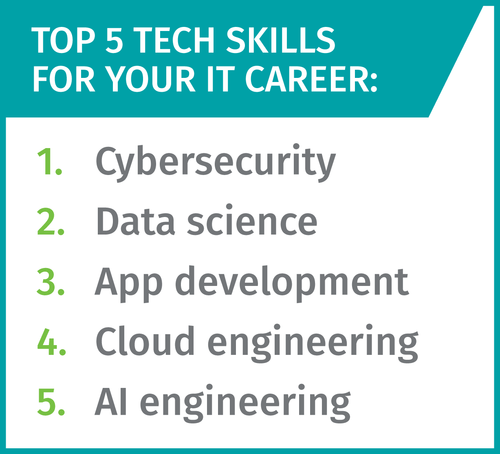Blog
< Back to Blogs
5 Must-Have Technical Skills for Today’s IT World

The business landscape is constantly being challenged by new technologies that are changing the way organisations operate and shaping the skills they need in their IT teams. If you want to be successful in the competitive IT field, it’s essential to keep up with the latest trends by continuously maintaining and updating your expertise.
In this blog, we’ve broken down a list of five must-have technical skills for IT professionals to help you identify the next step in your career and ensure you’re well-equipped to secure your ideal role.

1. Cybersecurity
We live in an age where the bulk of our information (both personal and work-related) is stored on hard drives or in the cloud, and paper documents have all but become obsolete. While this paperless world is saving us valuable office space, there are also major security risks associated with keeping our information online. Cyber-attacks are steadily on the rise and getting more complex, so cybersecurity professionals such as Security Engineers and Architects are in high demand as businesses seek to protect their (and their customers’) information from potential breaches.
This has opened the door for more cybersecurity specialists in the market who are able to take their pick of well-paying opportunities. Some of the key skills we suggest our cybersecurity experts have under their belts are:
- Intrusion detection
- Penetration testing
- Encryption skills
- DevSecOps
- Awareness of cloud security
2. Data Science
Data Scientists are becoming highly sought after (and the demand for these professionals is likely to grow even more in future), as businesses have a higher and more pressing need to collate and interpret data to understand changing customer trends, make better business decisions and have a more in-depth understanding of their own impact on the market.
For any candidates looking to build a career in Data Science, we suggest upskilling in R & Python, as well as gaining experience with real industry projects and case studies.
3. App Development
App development has rapidly become of the top IT skills in demand in the last few years as more and more organisations (private and public) look to launch apps to cater to their unique needs and stay relevant in the market. Whether it is for streamlining backend processes or selling products to customers, a growing number of organisations including SME’s, government and educational providers (to list but a mere few), are in need of developers to design, install, test and maintain mobile apps for them. Mobile Developers who can build apps using Apple’s IOS, Microsoft’s Windows Phone Platforms and Android are all in high demand.
iOS Developers:
For iOS development, being well-versed in Objective-C/ Swift, as well as competent using Cocoa Touch Framework and Xcode development will be desirable amongst employers.
Android Developers:
Android Developers should be proficient in Java.
4. Cloud Engineering
As the rate of cloud adoption continues to accelerate, Cloud Engineers have become an essential (and highly sought after) part of many IT Departments. There are two aspects to Cloud Engineers, one part is to design, plan, manage and maintain cloud computing, utilising both external systems and in-house technology. The other is to provide ongoing support to cloud applications and deployments to ensure they operate effectively by modifying, debugging and re-testing software as needed. Having experience in these areas will significantly increase IT candidates’ employability.
5. AI / Machine Learning Engineering
We’ve seen a lot of talk about AI on the tech pages and in the news recently, and while it’s still in the early stages of its development, AI will be part of day-to-day business in the very near future as many realise how useful (and financially viable) a tool it is for streamlining business processes. Already we’re seeing a need for Artificial Intelligence (AI) and Machine Learning Engineers to help organisations reach the next stages of automation, optimising day-to-day operations and taking over much of the more monotonous and repetitive work previously done by people. AI and Machine Learning Engineers will enable businesses to take advantage of computers that can gather data and use it to make decisions, as well as get work done faster and more efficiently.
Seeing as Artificial Intelligence is such a new concept, there is a notable lack of people with these skills, especially at management level. Consequently, developing AI and Machine Learning experience will be highly valuable for long term career growth.
Summary
Technology and IT is evolving in front of our eyes, and to stay ahead of the game, you have to change with it. This includes upskilling, further study and ensuring you have the must-have technical skills to guarantee long term employment in an IT job that will help you reach your career goals.
For any further information on the top IT skills currently in demand or specialist advice on the IT recruitment market, contact the team at EITR.
Share This Article
Recent Articles


Filter By Category
Subscribe to our News & Advice
We will get back to you as soon as possible.
Please try again later.





All content copyrighted Enterprise IT Resources © All rights reserved | Privacy Policy | Collection Statement | Powered with 💚 by Shazamme









